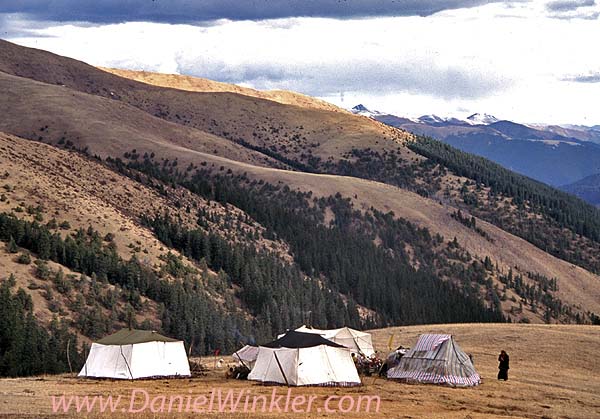Yartsa Gunbu season is peaking in Tibet right now. I heard from Kandze / Garze / Ganzi Tibetan Autonomous Prefecture [TAP, Sichuan] that the harvest is going well and that the price is higher than last year. I am glad to hear that. I was a bit worried, when I heard about the persistent drought in Yunnan. I was wondering if that drought would extent into the mountains of the upper Mekong catchment. However, already in the context of the devastating earth quake in Jyekundu / Jiegu / Yushu [see the links for donations below] there were reports of rains in Jyekundo. I hope to be able to report via this blog from my Cordyceps tour when we cross Kandze and Golok / Goluo [Qinghai] TAPs. I have to see how accessible the net will be in the Tibetan hinterland.

Yartsa gunbu collectors camp at Chungba La in Lithang in May 1999.
For the time being, I will post some links in here on this years reporting on Cordyceps. Each year we see more reports on the phenomena (see below). When I first got into caterpillar fungus it was such an exotic thing and I had a really hard time figuring out what I had encountered on the alpine pastures in Bachen in early June 1997. Of course the value was nowhere near where it is now, high up in the sky, but still the income from Yartsa gunbu was already very important back then and many communities relied on it as one of their main cash sources.
Now onto the reporting in the media:
A short clip in French "Les Cordyceps du Qinghai will introduce you to Yartsa gunbu harvest and trade in Qinghai:
An unnamed researcher from Beijing's Tibet Research Center (CTRC) has published an article "Tibet enters Cordyceps sinensis collection peak" on this years collection in Tibet AR including some interesting figuress" "Tibet enters cordyceps sinensis collection peak"
In China Daily Daniel Chinoy published an interesting 3 page article entitled "Rare fungus faces extinction " on April 15,. Much of the article is on the sourcing of Chinese medicinal material, its value and problems regarding sustainability, but a good junk is dedicated to dongchong xiacao = Caterpillar fungus. One page talks about collection and dealing in Qinghai and photos show Hui collectors and dealers. Chinoy quotes Yang Darong's absurd claim without naming him as his source, that nowadays only 10% are left of the production commonly harvested 20 years ago. As discussed earlier in this blog, this claim is not supported by real data.
Last, but not least, I discovered Shiva Devkota's blog spot with lots of interesting articles on Cordyceps and other fungi in Nepal and the Himalayas. Check it out!
